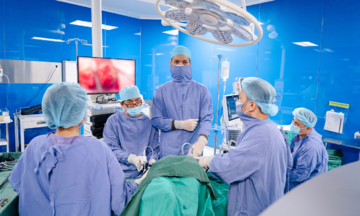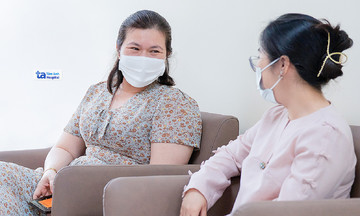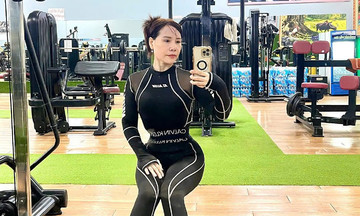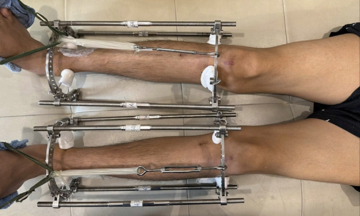At 20, Kien was shot in the right knee. His comrades carried him back to the bunker where a battlefield medical team performed surgery to debride, disinfect, and suture the wound. "The wound healed, but my right leg was about 3 cm shorter, and I walked with a bowlegged gait. Whenever the weather changed, the pain returned," Kien said.
By 2011, the pain intensified. He sought medical attention and was diagnosed with osteoarthritis. Kien received medical treatment and pain medication until recently, when they became ineffective. The knee pain became so severe that he couldn't sleep or walk outside. He often had to collapse and wait for the pain to subside. He then went to Tam Anh General Hospital in Hanoi for a knee replacement.
Dr. Che Dinh Nghia, deputy head of the Department of Trauma and Orthopedics, ordered X-rays, revealing severe osteoarthritis and axial deformity in Kien's right knee due to the old war injury. Shrapnel from the bullet was still present.
"The bullet had destroyed part of the tibial plateau, causing the patient's femur to collapse," Dr. Nghia said. Years of walking on the collapsed bone structure, with a limp, led to severe osteoarthritis. The soft tissue around the old wound had hardened, making the knee replacement surgery complex. The patient also had underlying conditions, including diabetes and heart disease, and had received a stent.
 |
Kien’s knee before surgery (left) showing collapse and severe osteoarthritis with shrapnel fragments, and after surgery (right) with reduced axial deviation and correction of the bowlegged gait. *Photo: Tam Anh General Hospital* |
Dr. Nghia ordered a multi-specialty examination, including cardiology and endocrinology, to assess Kien's overall health and determine his eligibility for surgery. A CT scan was performed to create a 3D model of the knee joint. Using the images, the doctor took measurements and developed a personalized surgical plan for Kien, including selecting the size of the artificial joint, determining the resection margins, and the placement of each component.
After administering spinal anesthesia, Dr. Nghia made a 10 cm incision from the tibial tuberosity to above the patella, exposing the joint to remove the damaged cartilage and bone, and implant the Medial Pivot artificial joint. The components of the artificial knee joint were precisely positioned, increasing the length of Kien's right leg by 2 cm and correcting the bowlegged deformity.
Post-surgery, Kien began rehabilitation and could walk with assistance after 24 hours. Three days later, he reported mild pain at the incision site but no pain in the joint. He was discharged on the occasion of the National Day holiday, 2/9.
 |
Dr. Nghia performing surgery. *Illustrative photo: Tam Anh General Hospital* |
Osteoarthritis occurs when the cartilage at the end of the knee joint gradually wears down and becomes damaged, causing pain, swelling, stiffness, and limited mobility due to bone-on-bone friction. It commonly affects older adults as part of the aging process. According to Dr. Nghia, a gunshot wound to the knee is a particularly severe injury, destroying much of the cartilage, ligaments, and bone structure of the knee joint, leading to instability and increased risk of chronic inflammation and osteoarthritis. Shrapnel fragments lodged in the synovial fluid of the joint for many years can also trigger inflammatory responses, exacerbating the condition.
For patients with end-stage osteoarthritis who no longer respond to medical treatment, total knee replacement surgery is recommended to restore mobility and prevent disability. After knee replacement, patients can still participate in low-impact physical activities: walking, swimming, and tai chi. High-impact activities like soccer and volleyball should be avoided. Artificial knee joints typically last about 20 years, but regular check-ups are necessary to monitor and maintain the joint's durability, ensuring a good quality of life.
Thanh Long
*The patient’s name has been changed.
| Readers can submit questions about musculoskeletal diseases here for doctors to answer. |












